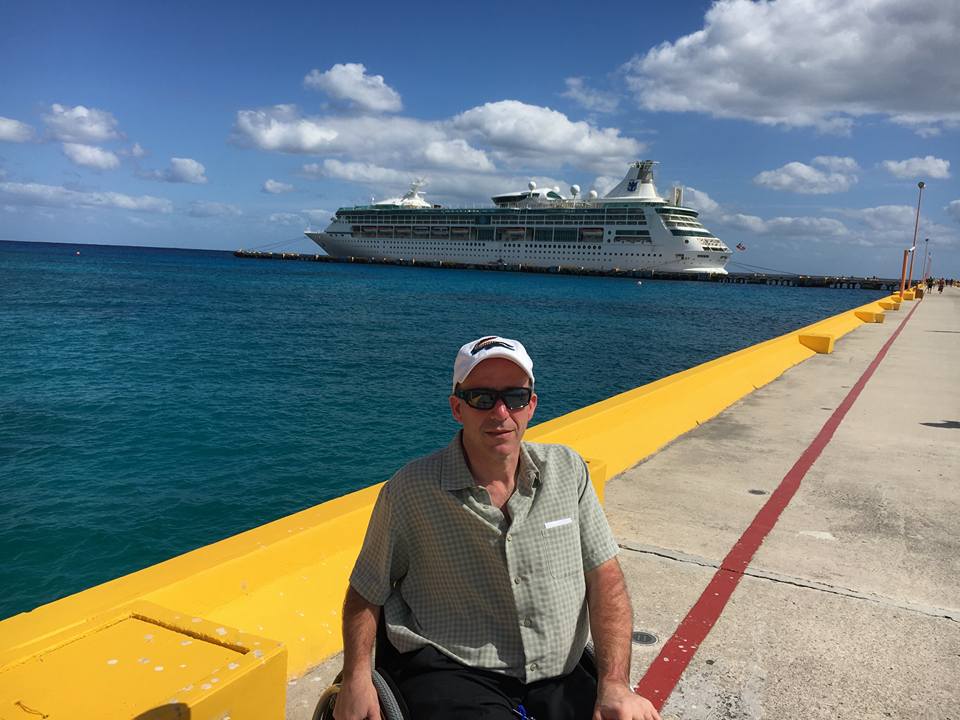Taking a cruise is a great way for individuals with disabilities to travel. It gives you the chance to see a lot of places, over a short period of time, without having to pack up and move around. It is so nice to be able to go out and explore new ports each day knowing that you will come back to a room that meets your needs…and tons of great food and entertainment.
I have taken several cruises and really have had a great experience each time. The most important thing that is necessary to make the trip work is to PLAN AHEAD. All cruise ships have accessible rooms, but there are only a limited number of them, and they can book quickly. You can check out different cruises, ships, and itineraries online, but you will need to call the booking agents directly to inquire about and reserve an accessible cabin.
Accessible cabins are usually larger than the regular cabins (no – they do not cost more!) to provide the access we need. The bathrooms are usually a little larger, and the rooms generally allow for more turning space. Roll-in showers are usually easy to use and have a bench built in or a plastic shower chair available. If you need more than that, you should make arrangements for rental equipment to be ordered and delivered to your room well in advance. You can consult with the cruise line directly, and they can direct you to their access department. Accessible rooms are usually closer to the elevators, which is very helpful. The floors on the inside of the ships are usually carpeted and can make for a bit of a workout, depending on your level of injury. Not having to push too far down the hallway is a nice bonus!
When trying to decide which cruise to take, look at the departure ports, learn about the distance from the airports to these ports, ask about transportation to and from, and start to make a short list. Next thing to learn is whether the boat will “dock” or “tender” at all of the ports that the ship will stop at. This is important information, as sometimes the boat is unable to dock, and they transport passengers from the ship to the shore aboard a “tender,” or smaller boat. If you see this is what is listed, you should ask if you can get off of the boat at this port. This could sometimes involve steps, and if you use a wheelchair, someone lifting you. Power chairs often can not be lifted off, but sometimes manual chairs can. PLEASE remember to ask this important question!
Once you have decided on a destination, now it is time to look at “excursions.” Every cruise line offers lots of these, but the big problem, if you are on a cruise outside of the continental United States, is that they often use buses that have steps. Never fear, though, as there are also tons of taxis at every port, happy to take you where you want to go to. In fact, while cruising myself, I have found that I was able to make my excursion better by taking a taxi. I could go exactly where I wanted to go, and stay as long as I wanted to stay, as opposed to being a part of a large tour on a tight schedule.
Not every destination that you stop in will require transportation to get to places. Often you can stroll around the town on your own and explore the shopping, museums, and food that each has to offer. You can ask the onboard excursion desk for helpful tips about each town, and they often will be able to help answer questions about accessibility too. In fact, I have found the onboard staff to be much more helpful than anyone I have spoken to over the phone in advance of the cruise.
When your big day arrives you will be beaming with excitement as you arrive and see just how massive these ships are. Travelers with disabilities go through a special entrance to board the ship and will move through the process quickly. Your luggage will be delivered to your room in a few hours, and you are ready to relax.
Often people ask about how the movement of the ship affects our movement on the ship. I can tell you that the seas are usually very smooth, and I have had no real problems. Occasionally you will feel the boat rock or sway, but no differently than an able bodied person – just hold on!
As I mentioned earlier, one of the best things about cruising is the chance to see a lot of places in a week’s time. The ships usually do most of their travel at night, and its an amazing feeling to wake up every morning in a different place. As your trip goes by, you will also look forward to the usual one or two days at sea as well. Because you are doing so much in each of the ports, it is nice to stay on the boat and just relax a bit, too.
These ships truly are like floating hotels, and our accessibility has usually been well thought out. The restaurants are easy to access, and, once you know which door to enter through, will be very enjoyable. There are movies, casinos, shops, mini-golf courses, and so much more. It has been great to be able to do so much onboard. As I close, here is a brief summary of some key tips that will be helpful to remember. I am pretty confident that once you take your first cruise, it will not be your last!
Mark’s Quick Cruising Tips
- Book early! Accessible cabins go quickly.
- Check on transportation from the airport to the ship and back.
- Remember to see if the ship will “dock” or “tender” at the different ports.
- Ask about the excursions that the ship provides to be sure if they are in accessible vehicles that will meet your needs.
- Consult the onboard staff about ways to get around at each port.
- Explore! Remember that you never know if you will get back to a destination again, so be sure to see all that you can while there.
- Have fun! (Oh yeah, don’t eat too much either. Cruises are known for the quantity and quality of their food!)

At the port at Costa Maya, Mexico on my most recent cruise this February









